Page contents
- Executive summary
- Objectives
- Findings and actions
- Delivering the Rights of Way Improvement Plan
- Rights of Way Improvement Plan and evidence reports
Every council which is responsible for public rights of way must produce a Rights of Way Improvement Plan. It sets out the council’s goals and priorities for public rights of way.
A Rights of Way Improvement Plan has to assess how well public rights of way meet the needs of the public. This includes those who already use public rights of way and those who would like to.
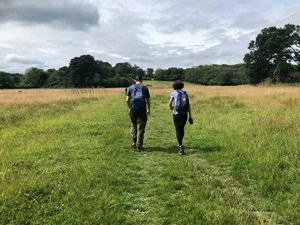
Executive summary
We asked the public, stakeholders and our partners for their views before we produced the Rights of Way Improvement Plan. This highlighted how much people value public rights of way, how important they are for health, mental wellbeing and for enjoying nature and that many use them regularly, often on a daily basis.
Feedback has helped us to understand what needs to be improved. We will report on what we have achieved to deliver the Rights of Way Improvement Plan our Annual Report, which will be published on this web page.
Objectives
The areas we need to improve are set out in our 11 objectives. Under these objectives are 28 actions which provide more detail on how we will deliver these improvements.
Objective 1: To improve our understanding of the needs of all our users, including those presently under-represented, to make sure that the rights of way network continues to evolve to meet their current and future needs.
Objective 2: That the network is as accessible as possible to as many people as possible, regardless of their physical mobility, disability, ethnicity, age, income or other factors, through working with partners, improving the quality of the network and providing information.
Objective 3: To maintain the network in the best possible condition, prioritising safety and targeting maintenance to where there is the greatest need.
Objective 4: To improve the condition of the public rights of way network through supporting others with a responsibility towards public rights of way, including landowners.
Objective 5: To uphold the council’s legal duties to provide an up-to-date definitive map and statement which is accessible to the public, and to execute other work streams in relation to legal work to record, protect and vary public rights of way, in order to underpin the objectives and actions in this Rights of Way Improvement Plan.
Objective 6: To ensure that development does not impact negatively on public rights of way or their users; that they are protected and any impacts on them are appropriately mitigated. This should be both within the development and in the wider catchment. Rights of Way requirements associated with Strategic sites should be included in Local Plans.
Objective 7: To improve the safety of our users in respect to the impacts of traffic, through seeking improved connections and crossings where there is the greatest need, working with partners on information and initiatives to improve safety and to support active travel, liveable neighbourhoods and recreation.
Objective 8: To ensure that public rights of way contribute to conserving and protecting the outstanding biodiversity, landscape and heritage of Surrey, whilst also providing opportunities to appreciate and understand them.
Objective 9: To protect the network from and adapt to the impacts of climate change through improving our maintenance techniques, applying best practice, seeking to innovate, using new materials and improving our understanding of changing weather patterns and other impacts on the public rights of way network.
Objective 10: To raise awareness of the public rights of way network and to support existing and new users with opportunities to find out about public rights of way, to explore them, to make the network a more welcoming place and to help people to find their way around.
Objective 11: To encourage responsible use of the countryside, to increase understanding and consideration between users and to lessen impacts on landowners, their businesses and livestock.
Findings and actions
Below are the areas which the Rights of Way Improvement plan aims to address. These are based on the feedback we received and our own research.
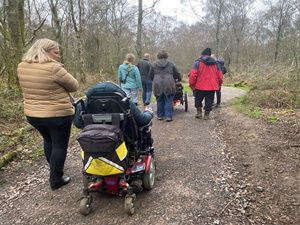 Finding 1: Not everyone has the same opportunity to benefit from Public rights of way
Finding 1: Not everyone has the same opportunity to benefit from Public rights of way
Actions to deliver this
Action 1: Establish, and over time evolve, an enhanced mapping interface with improved usability, showing routes and their accessibility, infrastructure, closures and restrictions, public transport and other information to support all users to make route choices.
Action 2: Identify priority areas for improving accessibility on the public rights of way network and deliver improvements to create continuous networks of more accessible routes.
Action 3: Work in partnership with landowners to continue to remove stiles from the network.
Action 4: Alongside our partners, including in public health, Active Surrey, the voluntary sector and others to raise awareness of the contribution and use of public rights of way to health, wellbeing, mental health, inclusivity and socio-economic goals. Embed these into policy and seek to secure additional funding for delivery of projects and improvements.
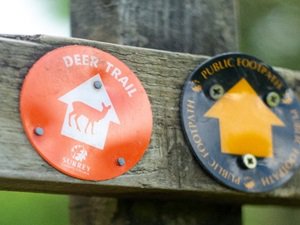 Finding 2: Maintaining paths is your highest priority
Finding 2: Maintaining paths is your highest priority
You told us that maintaining the existing public rights of way was your highest priority. Especially important to you is clearing vegetation. Other areas which you want us to address are lack of signing, poor surfaces and structures such as stiles being in poor condition.
Actions to deliver this
Action 5: Condition survey of the network to update location, condition and accessibility of structures and surfaces, and to be better informed to adapt to climate change impacts.
Action 6:Draw up an enforcement policy and publish on webpages.
Action 7: Develop an approach to prioritising surfacing works and to score these against the greatest need and impact. We will publish an explanation of the themes on our webpages.
Action 8: Improve usability of problem reporting system for customers and consider ways to improve feedback on the status of the problem.
Action 9: Continue to review the vegetation maintenance schedule to address areas of greatest need and impact. Publish on webpages. Identify routes where vegetation from the sides is having the greatest impact on users and address this through winter cuts or enforcement.
Action 10: Develop our working in partnership with parish and town councils and the major landowners who provide public access to achieve the best possible outcomes for the network and harnessing all available resources.
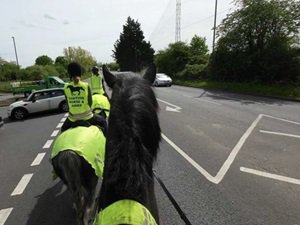
Finding 3: Safety of users on Public rights of way
Surrey has one of the busiest road networks in the country, carrying over 60% more than the national average amount of traffic.
Traffic has a negative impact on all our users. Most of our users are classed as vulnerable road users and are at a higher risk of injury or death in a collision. High traffic on many major roads, especially dual carriageways, can make crossing impossible and unsafe to use them to connect public rights of way.
Improving crossings and traffic-free connections between public rights of way can help to improve the safety of our users. We can also help to encourage people to walk, cycle or wheel for everyday journeys rather than use cars.
Actions to deliver this
Action 17: Seek connecting paths and crossings where these will address the greatest need and provide greatest benefit, prioritising safety.
Action 18: Work with partners to seek improvements in road safety, including awareness raising and signage.
Action 19: Support active travel, walkable neighbourhoods and liveable spaces, through improvements to public rights of way, signage and other measures.
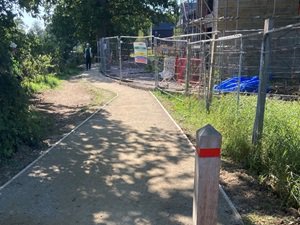
Finding 4: Protecting paths from development
Public rights of way are crucial in delivering sustainable growth – as a green infrastructure asset, in delivering sustainable travel and in supporting health and wellbeing and overall quality of life. In the future the amount of development in Surrey will increase. You were clear that you want us to protect public rights of way from development and the impact, for example from increased traffic, to secure improvements to public rights of way and improve connections and crossings.
Actions to deliver this
Action 15: Development Officer to ensure better outcomes from planning and development through Community Infrastructure Levy (CIL) and Section 106 and to respond to changes in planning law.
Action 16: Increase requests for developer contributions, including catchment-based considerations through greater involvement in the planning process.
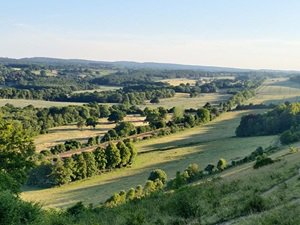
Finding 5: Ensure public rights of way are protected, for all to enjoy
Actions to deliver this:
Action 11: Maintain and update the definitive map and statement of public rights of way as well as the Register of Commons and Town and Village Greens.
Action 12: Redraw the definitive map and statement and republish in a digital format.
Action 13: Reduce the backlog of Definitive Map Modification Order (DMMO) work with the aim of meeting the proposed new 12 month determination timeframe under the Deregulation Act.
Action 14: To introduce new working practices and requirements set out in the proposed Deregulation Act and consolidate the definitive map and statement by 2030
Action 20: Protect and enhance biodiversity, heritage and landscape character in public rights of way maintenance and improvement.
Action 21: Identify structures, surfaces and other aspects at risk from the impacts of climate change, working with the Surrey County Council Flood and Climate Resilience Team to address impacts and seek new approaches and methods to address impacts.
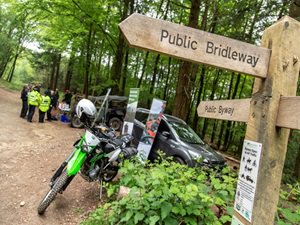
Finding 6: Improve information provision and communication
The need for responsible use of the countryside was a common theme raised by both our users and landowners. Everyone told us there has been an increase in users and issues such as aggressive dogs, people not staying on public rights of way, fly tipping and littering.
You told us that you want to be confident in knowing where to go in the countryside, and landowners told us that well waymarked paths are important to help people to stay on public rights of way. You want promoted routes to be well-marked and easy to follow.
Actions to deliver this
Action 22: Produce a waymarking policy for use by all who are developing waymarked self-guided trails.
Action 23: Agree with partners which of the routes they are promoting they will monitor. Put these on the maintenance system to streamline resolution of reported issues.
Action 24: Consider on site signage to indicate what users are permitted in the busiest areas or where clarification of rights would be helpful.
Action 25: Carry out regular social media and promotional campaigns to encourage responsible countryside use. Co-ordinate messages and timing with other partners.
Action 26: Seek to expand and improve our work with volunteers, including new roles, new people and providing training.
Action 27: Work with the Country Land and Business Association (CLA) and National Farmers Union (NFU) to improve regular communication and to disseminate information to landowners. Improve visibility and communication options for landowners.
Action 28: Seek funding, build new partnerships and improve communication to implement this Plan.
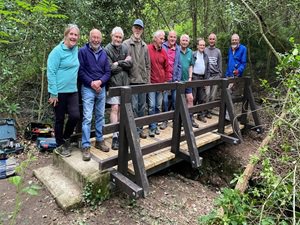
Delivering the Rights of Way Improvement Plan
Some of the actions in this Rights of Way Improvement Plan can be delivered with existing resources, but several will need additional resources. Our Operation and Delivery Plan will set out the projects and actions which will be taken forward in the short term.
We will prioritise our work based on the greatest need. Need will be assessed with regard to user safety, the number of users affected or who will benefit and the overall benefit to communities and the public rights of way network. We will be transparent in how we assess this need and publish how we will assess projects and priorities on our webpages.
Delivering many of the actions in the Rights of Way Improvement Plan will need partnership working with a range of stakeholders, both existing and new.
We will produce and publish an Annual Report to show what has been achieved to deliver the Rights of Way Improvement Plan in the past year and what we plan to achieve in the coming year.
Rights of Way Improvement Plan and evidence reports
The Rights of Way Improvement Plan 2025-2035 and two evidence reports are available to download below.
Files available to download
-
Rights of Way Improvement Plan 2025 to 2035 (PDF)
This draft plan is being consulted upon and provides detail on Surrey’s rights of way network and those who use it for work and leisure purposes. -
Rights of Way Improvement Plan Executive Summary (PDF)
This summary document provides an overview of Surrey’s 10 year Rights of Way Improvement Plan, highlighting the themes and objectives. -
Evidence Report 1 - Surveys and stakeholders report (PDF)
Rights of Way Improvement Plan: provides further detail on Surrey’s rights of way network and those who use it for work and leisure purposes -
Evidence Report 2 - Network and needs analysis (PDF)
Rights of Way Improvement Plan: provides further detail on Surrey’s rights of way network and those who use it for work and leisure purposes.

